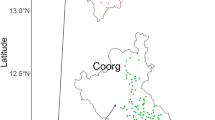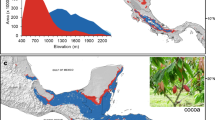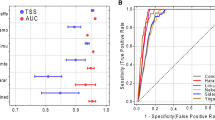Abstract
Coffee farming provides livelihoods for around 15 million farmers in Ethiopia and generates a quarter of the country's export earnings. Against a backdrop of rapidly increasing temperatures and decreasing rainfall, there is an urgent need to understand the influence of climate change on coffee production. Using a modelling approach in combination with remote sensing, supported by rigorous ground-truthing, we project changes in suitability for coffee farming under various climate change scenarios, specifically by assessing the exposure of coffee farming to future climatic shifts. We show that 39–59% of the current growing area could experience climatic changes that are large enough to render them unsuitable for coffee farming, in the absence of significant interventions or major influencing factors. Conversely, relocation of coffee areas, in combination with forest conservation or re-establishment, could see at least a fourfold (>400%) increase in suitable coffee farming area. We identify key coffee-growing areas that are susceptible to climate change, as well as those that are climatically resilient.
This is a preview of subscription content, access via your institution
Access options
Access Nature and 54 other Nature Portfolio journals
Get Nature+, our best-value online-access subscription
$29.99 / 30 days
cancel any time
Subscribe to this journal
Receive 12 digital issues and online access to articles
$119.00 per year
only $9.92 per issue
Buy this article
- Purchase on Springer Link
- Instant access to full article PDF
Prices may be subject to local taxes which are calculated during checkout






Similar content being viewed by others
References
Minten, B., Tamru, S., Kuma, T. & Nyarko, Y. Structure and Performance of Ethiopia's Coffee Export Sector. Working paper 66 (EDRI/IFPRI, 2014).
Historical Data on the Global Coffee Trade (ICO, 2016); http://www.ico.org/new_historical.asp (2016).
Chemonics International. Ethiopia Coffee Industry Value Chain Analysis. Profiling the Actors, their Interactions, Costs, Constraints and Opportunities (USAID, 2010); http://agoa.info/toolkit/downloads/5157.html
Tefera, A. Ethiopia: Coffee Annual Report. GAIN Report Number ET1514 (USDA Foreign Agricultural Service, 2015).
Hailu, B., Maeda, E. E., Heiskanen, J. & Pellikka, P. Reconstructing pre-agricultural expansion vegetation cover of Ethiopia. Appl. Geogr. 62, 357–365 (2015).
Friis, I., Demissew, S. & Breugel, P. V. Atlas of the potential vegetation of Ethiopia. Biol. Skrif. 58, 1–307 (2010).
Dudu, V. P. Impacts of Climate Change on Coffee Farming in Ethiopia (LAP Lambert Academic, 2012).
Craparo, A. C. W., Van Asten, P. J. A., Läderach, A., Jassogneb, L. T. P. & Graba, S. W. Coffea arabica yields decline in Tanzania due to climate change: global implications. Agr. Forest Meteorol. 207, 1–10 (2015).
McSweeney, C., New, M. & Lizcano, G. UNDP Climate Change Country Profiles: Ethiopia (UNDP, 2010); http://www.geog.ox.ac.uk/research/climate/projects/undp-cp/UNDP_reports/Ethiopia/Ethiopia.hires.report.pdf
Jury, M. R. & Funk, C. Climatic trends over Ethiopia: regional signals and drivers. Int. J. Climatol. 33, 1924–1935 (2013).
Siraj, A. S. et al. Altitudinal changes in malaria incidence in highlands of Ethiopia and Colombia. Science 243, 1154–1158 (2014).
Mekasha, A., Tesfaye, K. & Duncan, J. Trends in daily observed temperature and precipitation over three Ethiopian eco-environments. Int. J. Climatol. 34, 1990–1999 (2014).
Williams, A. P. & Funk, C. A westward extension of the warm pool leads to a westward extension of the walker circulation, drying Eastern Africa. Clim. Dynam. 37, 2417–2435 (2011).
Rowell, D. P., Booth, B. B. B., Nicholson, S. E. & Good, P. Reconciling past and future rainfall trends over east Africa. J. Climate 28, 9768–9788 (2015).
Seleshi, Y. & Camberlin, P. Recent changes in dry spell and extreme rainfall events in Ethiopia. Theor. Appl. Climatol. 83, 181–191 (2006).
Viste, E., Korecha, D. & Sorteberg, A. Recent drought and precipitation tendencies in Ethiopia. Theor. Appl. Climatol. 112, 535–551 (2013).
Funk, C. et al. A Climate Trend Analysis of Ethiopia, USGS Fact Sheet 2012–3053 (USGS, 2012).
Funk, C. et al. Warming of the Indian Ocean threatens eastern and southern African food security but could be mitigated by agricultural development. Proc. Natl Acad. Sci. USA 105, 11081–11086 (2008).
Funk, C. et al. Recent Drought Tendencies in Ethiopia and Equatorial Subtropical Eastern Africa (FEWS NET, 2005).
Williams, A. P. et al. Recent summer precipitation trends in the greater horn of Africa and the emerging role of Indian ocean sea surface temperature. Clim. Dynam. 39, 2307–2328 (2012).
Conway, D. & Schipper, E. L. F. Adaptation to climate change in Africa: challenges and opportunities identified from Ethiopia . Glob. Environ. Chang. 21, 227–237 (2011).
IPCC Summary for Policymakers (eds Stocker, T. F. et al.) (Cambridge Univ. Press, 2013).
IPCC Climate Change 2014: Impacts, Adaptation, and Vulnerability (eds Barros, V. R. et al.) (Cambridge Univ. Press, 2014).
Ramirez-Villegas, J., Challinor, A. J., Thornton, P. K. & Jarvis, A. Implications of regional improvement in global climate models for agricultural impact research. Environ. Res. Lett. 8, 24018 (2013).
Davis, A. P., Gole, T. W., Baena, S. & Moat, J. The impact of climate change on natural populations of Arabica coffee: predicting future trends and identifying priorities. PLoS ONE 7, e47981 (2012).
Landsat Missions: Landsat 8 (USGS, accessed February 2014); http://landsat.usgs.gov/landsat8.php
Schroth, G . et al. Towards a climate change adaptation strategy for coffee communities and ecosystems in the Sierra Madre de Chiapas, Mexico. Mitig. Adapt. Strateg. Glob. Change 14, 605–625 (2009).
Baca, M ., Laderach, P ., Haggar, J ., Schroth, G. & Ovalle, O. An integrated framework for assessing vulnerability to climate change and developing adaptation strategies for coffee growing families in Mesoamerica. PLoS ONE 9, e88463 (2014).
Magrach, A. & Ghazoul, J. Climate and pest-driven geographic shifts in global coffee production: implications for forest cover, biodiversity and carbon storage. PLoS ONE 10, e0133071 (2015).
Bunn, C., Läderach, P., Pérez Jimenez, J. G., Montagnon, C. & Schilling, T. Multiclass classification of agro-ecological zones for Arabica coffee: an improved understanding of the impacts of climate change. PLoS ONE 10, e0140490 (2015).
Ovalle-Rivera, O., Läderach, P., Bunn, C., Obersteiner, M. & Schroth, G. Projected shifts in coffea arabica suitability among major global producing regions due to climate change. PLoS ONE 10, e0124155 (2015).
Bunn, C. P. L., Ovalle-Rivera, O . & Kirschke, D. A bitter cup: climate change profile of global production of Arabica and robusta coffe. Clim. Change 129, 89–101 (2015).
Chemura, A., Kutywayo, D., Chidoko, P. & Mahoya, C. Bioclimatic modelling of current and projected climatic suitability of coffee (Coffea arabica) production in Zimbabwe. Reg. Environ. Change 16, 473–485 (2016).
Hijmans, R. J., Cameron, S. E., Parra, J. L., Jones, P. G. & Jarvis, A. Very high resolution interpolated climate surfaces for global land areas. Int. J. Climatol. 25, 1965–1978 (2005).
Dawson, T. P., Jackson, S. T., House, J. I., Prentice, I. C. & Mace, G. M. Beyond predictions: biodiversity conservation in a changing climate. Science 332, 53–58 (2011).
Foden, W. & Young, B. E. IUCN SSC Guidelines for Assessing Species’ Vulnerability to Climate Change Version 1.0. Occasional Paper of the IUCN Species Survival Commission No. 59 (IUCN, 2016); https://portals.iucn.org/library/sites/library/files/documents/SSC-OP-059.pdf
Meehl, G. A. et al. The WCRP CMIP3 multi-model dataset: a new era in climate change research. Bull. Amer. Meteor. Soc. 88, 1383–1394 (2007).
Taylor, K. E., Stouffer, R. J. & Meehl, G. A. An overview of CMIP5 and the experiment design. Bull. Amer. Meteor. Soc. 93, 485–498 (2012).
Knutti, R. & Sedláček, J. Robustness and uncertainties in the new CMIP5 climate model projections. Nat. Clim. Chang. 3, 369–373 (2013).
Tierney, J. E., Ummenhofer, C. C. & deMenocal, P. B. Past and future rainfall in the Horn of Africa. Sci. Adv. 1, e1500682 (2015).
Wiens, J. A., Stralberg, D., Jongsomjit, D., Howell, C. A. & Snyder, M. A. Niches, models, and climate change: assessing the assumptions and uncertainties. Proc. Natl Acad. Sci. USA 106, 19729–19736 (2009).
Boot, W. J. Ethiopian Coffee Buying Manual: Practical Guidelines for Purchasing and Importing Ethiopian Speciality Coffee Beans. (USAID, 2011); https://bootcoffee.com/wp-content/uploads/2013/01/Ethiopian_Coffee_Buying_Guide.pdf
Rodrigues, W. P. et al. Long-term elevated air [CO2] strengthens photosynthetic functioning and mitigates the impact of supra-optimal temperatures in tropical Coffea arabica and C. canephora species. Glob. Change Biol. 22, 415–431 (2016).
Cook, K. H. & Vizy, E. K. Impact of climate change on mid-twenty-first century growing seasons in Africa. Clim. Dynam. 39, 2937–2955 (2012).
Wrigley, G. Coffee – Tropical Agriculture Series (Longman Scientific & Technical, 1988).
Wellman, F. L. Coffee: Botany, Cultivation and Utilization (L. Hill; Interscience, 1961).
Ainsworth, E. A. & Long, S. P. What have we learned from 15 years of free-air CO2 enrichment (FACE)? A meta-analytic review of the responses of photosynthesis, canopy properties and plant production to rising CO2 . New Phytol. 165, 351–372 (2005).
Ainsworth, E. A., Leakey, A., Ort, D. R. & Long, S. P. FACE-ing the facts: inconsistencies and interdependence among field, chamber and modeling studies of elevated [CO2] impacts on crop yield and food supply. New Phytol. 179, 5–9 (2008).
Manderscheid, R., Erbs, M. & Weigel, H.-J. Interactive effects of free-air CO2 enrichment and drought stress on maize growth. Eur. J. Agron. 52, 11–21 (2014).
Long, S. P., Ainsworth, E. A., Leakey, A. D. B., Nösberger, J. & Ort, D. R. Food for thought: lower-than-expected crop yield stimulation with rising CO2 concentrations. Science 312, 1918–1921 (2006).
Jaramillo, J. et al. Some like it hot: the influence and implications of climate change on coffee berry borer (Hypothenemus hampei) and coffee production in East Africa. PLoS ONE 6, e24528 (2011).
Hein, L. & Gatzweiler, F. The economic value of coffee (Coffea arabica) genetic resources. Ecol. Econ. 60, 176–185 (2006).
The World Database on Protected Areas (UNEP/WCMC, 2016); http://www.protectedplanet.net
Matthew, M. W. et al. Status of atmospheric correction using a MODTRAN4-based algorithm. Proc. SPIE 4049, VI, 199–207 (2000).
Zhu, Z., Wang, S. & Woodcock, C. E. Improvement and expansion of the Fmask algorithm: cloud, cloud shadow, and snow detection for Landsats 4–7, 8, and Sentinel 2 images. Remote Sens. Environ. 159, 269–277 (2015).
Kriegler, F. J., Malila, W. A., Nalepka, R. F. & Richardson, W. Preprocessing transformations and their effects on multispectral recognition. Proc. 6th Intl. Symp. on Remote Sensing of Environment Vol. II, 97–131 (1969).
Kadmon, R., Farber, O. & Danin, A. Effect of roadside bias on the accuracy of predictive maps produced by bioclimatic models. Ecol. Appl. 14, 401–413 (2004).
Franklin, J. Mapping Species Distributions 1st edn (Cambridge Univ. Press, 2010).
Jiménez-Valverde, A., Lobo, J. & Hortal, J. Not as good as they seem: the importance of concepts in species distribution modelling. Divers. Distrib. 14, 885–890 (2008).
Anthony, F. M. et al. Genetic diversity of wild coffee (Coffea arabica L.) using molecular markers. Euphytica 118, 53–65 (2001).
Aga, A., Bryngelsson, T., Bekele, E. & Salomon, B. Genetic diversity of forest arabica coffee (Coffea arabica L.) in Ethiopia as revealed by random amplified polymorphic DNA (RAPD) analysis. Hereditas 138, 36–46 (2003).
Lashermes, P., Trouslot, P., Anthony, F., Combes, M. C. & Charrier, A. Genetic diversity for RAPD markers between cultivated and wild accessions of Coffea arabica. Euphytica 87, 59–64 (1996).
Montagnon, C. & Bouharmont, P. Multivariate analysis of phenotypic diversity of Coffea arabica. Genet. Resour. Crop. Ev. 43, 221–227 (1996).
Burkhardt, J., Kufa, T., Beining, A., Goldbach, H. E. & Fetene, M. in 21st International Conference on Coffee Science, 1032–1036 (2007).
Thuiller, W., Georges, D. & Engler, R. Biomod2: Ensemble platform for species distribution modeling. R package v.3.1-64 (CRAN, 2014); http://CRAN.R-project.org/package=biomod2
Phillips, S. J., Dudik, M. & Schapire, R. E. in Proc. 21st International Conference on Machine Learning Vol. 69, 655–662 (ACM Press, 2004).
Phillips, S. J., Anderson, R. P. & Schapire, R. E. Maximum entropy modelling of species geographic distributions. Ecol. Model. 190, 231–259 (2006).
Phillips, S. J. & Dudik, M. Modeling of species distributions with Maxent: new extensions and a comprehensive evaluation. Ecography 31, 161–175 (2008).
Thuiller, W., Lafourcade, B., Engler, R. & Araújo, M. B. Biomod—a platform for ensemble forecasting of species distributions. Ecography 32, 369–373 (2009).
Araujo, M. B. & New, M. Ensemble forecasting of species distributions. Trends. Ecol. Evo. 22, 42–47 (2007).
Thuiller, W., Lafourcade, B. & Araujo, M. B. Presentation for BIOMOD (2010); http://r-forge.r-project.org/scm/viewvc.php/*checkout*/pkg/inst/doc/Biomod_Presentation_Manual.pdf?revision=218&root=biomod&pathrev=218
Pearson, R. G. Species distribution modelling for conservation educators and practitioners (American Museum of Natural History, 2008); http://ncep.amnh.org
Knutti, R., Furrer, R., Tebaldi, C., Cermak, J. & Meehl, G. A. Challenges in combining projections from multiple climate models. J. Climate 23, 2739–2758 (2010).
Jury, M. R. Statistical evaluation of CMIP5 climate change model simulations for the Ethiopian highlands. Int. J. Climatol. 35, 37–44 (2014).
Tabor, K. & Williams, J. W. Globally downscaled climate projections for assessing the conservation impacts of climate change. Ecol. Appl. 20, 554–565 (2010).
Ramirez-Villegas, J. & Jarvis, A. Downscaling Global Circulation Model Outputs: The Delta Method Decision and Policy Analysis Working Paper No. 1 (CIAT, 2010); http://ccafs-climate.org/downloads/docs/Downscaling-WP-01.pdf
Busby, J. R. in Nature conservation: cost effective biological surveys and data analysis (eds Margules, C. R. & Austin, M. P. ) 64–68 (CSIRO, 1991).
Statistical Downscaling (Delta Method) CMIP3 (CGIAR/CCAFS, accessed February 2017); http://ccafs-climate.org/statistical_downscaling_delta/
Statistical Downscaling (Delta Method) CMIP5 (CGIAR/CCAFS, accessed February 2017); http://ccafs-climate.org/statistical_downscaling_delta_cmip5/
Acknowledgements
This study was conducted for the project Building a Climate Resilient Coffee Economy for Ethiopia, within the Strategic Climate Institutions Programme (SCIP) Fund, financed by the governments of the UK (DFID), Denmark and Norway. We are grateful to in-country project partners (Ethiopian Biodiversity Institute, National Meteorology Agency, Ministry of Environment and Forest, Ministry of Agriculture, Addis Ababa University and the Oromia Coffee Farmers' Cooperative Union (OCFCU)), fund managers KPMG (Ethiopia), Department for International Development (DFiD, Ethiopia) and the Ethiopian Commodity Exchange (ECX). We thank: those individuals that assisted with fieldwork, including D. Chomen (OCFCU), R. O'Sullivan (RBG, Kew) and E. Sage (Speciality Coffee Association of America); C. Schmitt (University of Freiburg) for the use of coffee plot study data; D. Georges (LECA, CNRS) for helping with issues in R and the Biomod2 package; A. Cooper (RBG Kew) for providing assistance with image processing in ENVI; and A. Moat, S. Bachman (RBG Kew), R. Fields and D. Boyd (University of Nottingham) for reviewing earlier versions of this contribution. We also acknowledge the Program for Climate Model Diagnosis and Intercomparison and the WCRP's Working Group on Coupled Modelling for their roles in making available the WCRP CMIP3 and CMIP5 multi-model dataset. Support of these datasets is provided by the Office of Science, US Department of Energy. We gratefully acknowledge coffee farmers and coffee farming communities across Ethiopia for their participation in the SCIP project, and especially for their hospitality and assistance during field work.
Author information
Authors and Affiliations
Contributions
J.M. and A.P.D. conceived and led the study; A.P.D. and J.M. led the project; all authors collected data; J.M., A.P.D., J.W., S.B. and T.W. analysed and processed the data. J.M. and A.P.D. wrote the paper with contributions from all authors.
Corresponding authors
Ethics declarations
Competing interests
The authors declare no competing financial interests.
Supplementary information
Supplementary Information
Supplementary Figures 1–17, Supplementary Notes, Supplementary Tables 1–4, Supplementary References. (PDF 2100 kb)
Rights and permissions
About this article
Cite this article
Moat, J., Williams, J., Baena, S. et al. Resilience potential of the Ethiopian coffee sector under climate change. Nature Plants 3, 17081 (2017). https://doi.org/10.1038/nplants.2017.81
Received:
Accepted:
Published:
DOI: https://doi.org/10.1038/nplants.2017.81
This article is cited by
-
Preparing Colombian coffee production for climate change: Integrated spatial modelling to identify potential robusta coffee (Coffea canephora P.) growing areas
Climatic Change (2024)
-
From climate perceptions to actions: A case study on coffee farms in Ethiopia
Ambio (2024)
-
Spatial predictions for the distribution of woody plant species under different land-use scenarios in southwestern Ethiopia
Landscape Ecology (2023)
-
Whole-genome resequencing of Coffea arabica L. (Rubiaceae) genotypes identify SNP and unravels distinct groups showing a strong geographical pattern
BMC Plant Biology (2022)
-
Vapour pressure deficit determines critical thresholds for global coffee production under climate change
Nature Food (2022)




